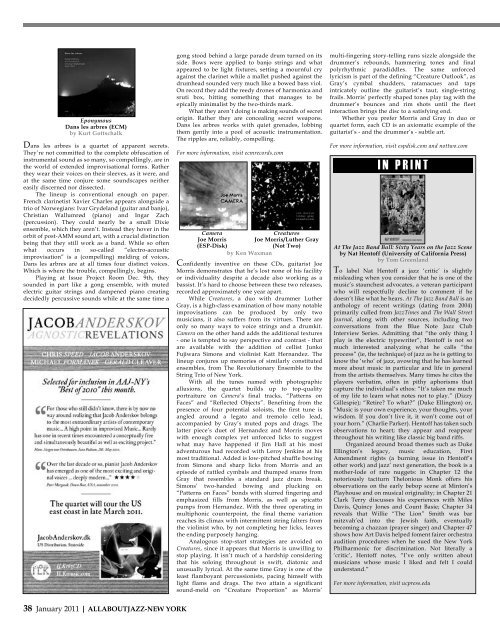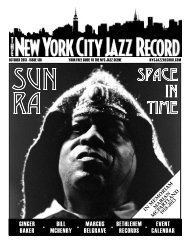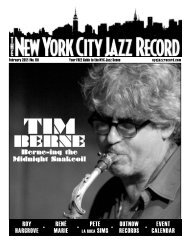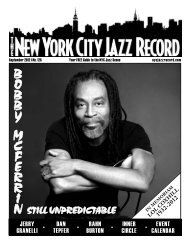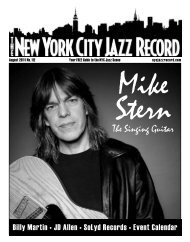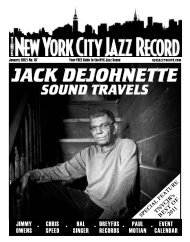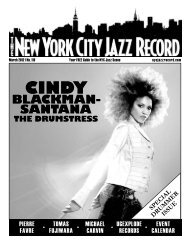heart of gold - The New York City Jazz Record
heart of gold - The New York City Jazz Record
heart of gold - The New York City Jazz Record
Create successful ePaper yourself
Turn your PDF publications into a flip-book with our unique Google optimized e-Paper software.
Eponymous<br />
Dans les arbres (ECM)<br />
by Kurt Gottschalk<br />
Dans les arbres is a quartet <strong>of</strong> apparent secrets.<br />
<strong>The</strong>y’re not committed to the complete obfuscation <strong>of</strong><br />
instrumental sound as so many, so compellingly, are in<br />
the world <strong>of</strong> extended improvisational forms. Rather<br />
they wear their voices on their sleeves, as it were, and<br />
at the same time conjure some soundscapes neither<br />
easily discerned nor dissected.<br />
<strong>The</strong> lineup is conventional enough on paper.<br />
French clarinetist Xavier Charles appears alongside a<br />
trio <strong>of</strong> Norwegians: Ivar Grydeland (guitar and banjo),<br />
Christian Wallumrød (piano) and Ingar Zach<br />
(percussion). <strong>The</strong>y could nearly be a small Dixie<br />
ensemble, which they aren’t. Instead they hover in the<br />
orbit <strong>of</strong> post-AMM sound art, with a crucial distinction<br />
being that they still work as a band. While so <strong>of</strong>ten<br />
what occurs in so-called “electro-acoustic<br />
improvisation” is a (compelling) melding <strong>of</strong> voices,<br />
Dans les arbres are at all times four distinct voices.<br />
Which is where the trouble, compellingly, begins.<br />
Playing at Issue Project Room Dec. 9th, they<br />
sounded in part like a gong ensemble, with muted<br />
electric guitar strings and dampened piano creating<br />
decidedly percussive sounds while at the same time a<br />
38 January 2011 | ALLABOUTJAZZ-NEW YORK<br />
gong stood behind a large parade drum turned on its<br />
side. Bows were applied to banjo strings and what<br />
appeared to be light fixtures, setting a mournful cry<br />
against the clarinet while a mallet pushed against the<br />
drumhead sounded very much like a bowed bass viol.<br />
On record they add the reedy drones <strong>of</strong> harmonica and<br />
sruti box, hitting something that manages to be<br />
epically minimalist by the two-thirds mark.<br />
What they aren’t doing is making sounds <strong>of</strong> secret<br />
origin. Rather they are concealing secret weapons.<br />
Dans les arbres works with quiet grenades, lobbing<br />
them gently into a pool <strong>of</strong> acoustic instrumentation.<br />
<strong>The</strong> ripples are, reliably, compelling.<br />
For more information, visit ecmrecords.com<br />
Camera<br />
Joe Morris<br />
(ESP-Disk)<br />
Creatures<br />
Joe Morris/Luther Gray<br />
(Not Two)<br />
by Ken Waxman<br />
Confidently inventive on these CDs, guitarist Joe<br />
Morris demonstrates that he’s lost none <strong>of</strong> his facility<br />
or individuality despite a decade also working as a<br />
bassist. It’s hard to choose between these two releases,<br />
recorded approximately one year apart.<br />
While Creatures, a duo with drummer Luther<br />
Gray, is a high-class examination <strong>of</strong> how many notable<br />
improvisations can be produced by only two<br />
musicians, it also suffers from its virtues. <strong>The</strong>re are<br />
only so many ways to voice strings and a drumkit.<br />
Camera on the other hand adds the additional textures<br />
- one is tempted to say perspective and contrast - that<br />
are available with the addition <strong>of</strong> cellist Junko<br />
Fujiwara Simons and violinist Katt Hernandez. <strong>The</strong><br />
lineup conjures up memories <strong>of</strong> similarly constituted<br />
ensembles, from <strong>The</strong> Revolutionary Ensemble to the<br />
String Trio <strong>of</strong> <strong>New</strong> <strong>York</strong>.<br />
With all the tunes named with photographic<br />
allusions, the quartet builds up to top-quality<br />
portraiture on Camera’s final tracks, “Patterns on<br />
Faces” and “Reflected Objects”. Benefiting from the<br />
presence <strong>of</strong> four potential soloists, the first tune is<br />
angled around a legato and tremolo cello lead,<br />
accompanied by Gray’s muted pops and drags. <strong>The</strong><br />
latter piece’s duet <strong>of</strong> Hernandez and Morris moves<br />
with enough complex yet unforced licks to suggest<br />
what may have happened if Jim Hall at his most<br />
adventurous had recorded with Leroy Jenkins at his<br />
most traditional. Added is low-pitched shuffle bowing<br />
from Simons and sharp licks from Morris and an<br />
episode <strong>of</strong> rattled cymbals and thumped snares from<br />
Gray that resembles a standard jazz drum break.<br />
Simons’ two-handed bowing and plucking on<br />
“Patterns on Faces” bonds with slurred fingering and<br />
emphasized fills from Morris, as well as spicatto<br />
pumps from Hernandez. With the three operating in<br />
multiphonic counterpoint, the final theme variation<br />
reaches its climax with intermittent string falters from<br />
the violinist who, by not completing her licks, leaves<br />
the ending purposely hanging.<br />
Analogous stop-start strategies are avoided on<br />
Creatures, since it appears that Morris is unwilling to<br />
stop playing. It isn’t much <strong>of</strong> a hardship considering<br />
that his soloing throughout is swift, diatonic and<br />
unusually lyrical. At the same time Gray is one <strong>of</strong> the<br />
least flamboyant percussionists, pacing himself with<br />
light flams and drags. <strong>The</strong> two attain a significant<br />
sound-meld on “Creature Proportion” as Morris’<br />
multi-fingering story-telling runs sizzle alongside the<br />
drummer’s rebounds, hammering tones and final<br />
polyrhythmic paradiddles. <strong>The</strong> same unforced<br />
lyricism is part <strong>of</strong> the defining “Creature Outlook”, as<br />
Gray’s cymbal shudders, ratamacues and taps<br />
intricately outline the guitarist’s taut, single-string<br />
frails. Morris’ perfectly shaped tones play tag with the<br />
drummer’s bounces and rim shots until the fleet<br />
interaction brings the disc to a satisfying end.<br />
Whether you prefer Morris and Gray in duo or<br />
quartet form, each CD is an axiomatic example <strong>of</strong> the<br />
guitarist’s - and the drummer’s - subtle art.<br />
For more information, visit espdisk.com and nottwo.com<br />
IN PRINT<br />
At <strong>The</strong> <strong>Jazz</strong> Band Ball: Sixty Years on the <strong>Jazz</strong> Scene<br />
by Nat Hent<strong>of</strong>f (University <strong>of</strong> California Press)<br />
by Tom Greenland<br />
To label Nat Hent<strong>of</strong>f a jazz ‘critic’ is slightly<br />
misleading when you consider that he is one <strong>of</strong> the<br />
music’s staunchest advocates, a veteran participant<br />
who will respectfully decline to comment if he<br />
doesn’t like what he hears. At <strong>The</strong> <strong>Jazz</strong> Band Ball is an<br />
anthology <strong>of</strong> recent writings (dating from 2004)<br />
primarily culled from <strong>Jazz</strong>Times and <strong>The</strong> Wall Street<br />
Journal, along with other sources, including two<br />
conversations from the Blue Note <strong>Jazz</strong> Club<br />
Interview Series. Admitting that “the only thing I<br />
play is the electric typewriter”, Hent<strong>of</strong>f is not so<br />
much interested analyzing what he calls “the<br />
process” (ie, the technique) <strong>of</strong> jazz as he is getting to<br />
know the ‘who’ <strong>of</strong> jazz, avowing that he has learned<br />
more about music in particular and life in general<br />
from the artists themselves. Many times he cites the<br />
players verbatim, <strong>of</strong>ten in pithy aphorisms that<br />
capture the individual’s ethos: “It’s taken me much<br />
<strong>of</strong> my life to learn what notes not to play.” (Dizzy<br />
Gillespie); “Retire? To what?” (Duke Ellington) or,<br />
“Music is your own experience, your thoughts, your<br />
wisdom. If you don’t live it, it won’t come out <strong>of</strong><br />
your horn.” (Charlie Parker). Hent<strong>of</strong>f has taken such<br />
observations to <strong>heart</strong>; they appear and reappear<br />
throughout his writing like classic big band riffs.<br />
Organized around broad themes such as Duke<br />
Ellington’s legacy, music education, First<br />
Amendment rights (a burning issue in Hent<strong>of</strong>f’s<br />
other work) and jazz’ next generation, the book is a<br />
mother-lode <strong>of</strong> rare nuggets: in Chapter 12 the<br />
notoriously taciturn <strong>The</strong>lonious Monk <strong>of</strong>fers his<br />
observations on the early bebop scene at Minton’s<br />
Playhouse and on musical originality; in Chapter 21<br />
Clark Terry discusses his experiences with Miles<br />
Davis, Quincy Jones and Count Basie; Chapter 34<br />
reveals that Willie “<strong>The</strong> Lion” Smith was bar<br />
mitzvah’ed into the Jewish faith, eventually<br />
becoming a chazzan (prayer singer) and Chapter 47<br />
shows how Art Davis helped foment fairer orchestra<br />
audition procedures when he sued the <strong>New</strong> <strong>York</strong><br />
Philharmonic for discrimination. Not literally a<br />
‘critic’, Hent<strong>of</strong>f notes, “I’ve only written about<br />
musicians whose music I liked and felt I could<br />
understand.”<br />
For more information, visit ucpress.edu


